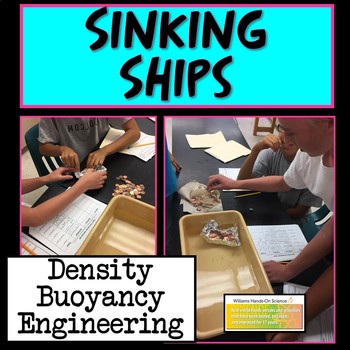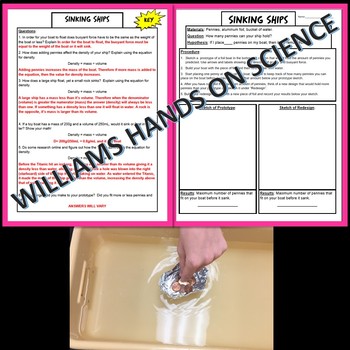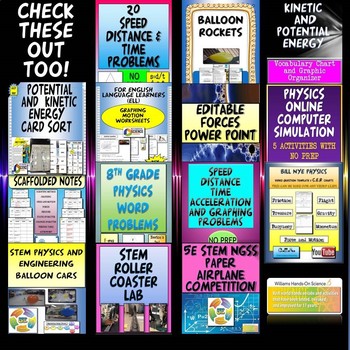Forces and Motion Lab NGSS MS-PS2-2 Density and Buoyancy
- Zip
What educators are saying
Description
This product makes learning about density and buoyancy fun and it’s a great challenge that the kids really get into! It’s easy prep and the only materials you need are about $1.50 in pennies per group, an approximately 20x15cm piece of aluminum foil and a bucket full of water.
I show a quick clip from YouTube about how the titanic sank in terms of density and buoyancy. Then we discuss as a class how adding pennies to an aluminum foil boat is like the Titanic taking on water after it hit the iceberg and how the added mass affects density and buoyant force.
I then have the students state their hypothesis, “If I place____ pennies on my boat, then it will remain floating.” Typically, students predict anywhere from 5-20 pennies and to their amazement student can place anywhere from 50-150 pennies! After we discuss their hypothesis as a class I have them sketch and discuss their prototype and they must label the direction of gravity and buoyant force.
I have one piece of 20x15cm piece of foil prepared for each group along with a bucket for water and enough pennies for about $1.50 per group. The students can then begin to build their boat, but emphasis that aluminum foil is delicate and can tear very easily. Also, remind them to count one penny at a time and then record the total number of pennies underneath their prototype drawing.
We then discuss the results, talk about what group placed the most pennies on their boat and why using the equation for density. This is a good time to emphasize that keeping volume as big as possible keeps the density down and makes the boat more buoyant.
After the discussion, I tell them to discuss like engineers the problems with their prototype, how to fix those problems and sketch a redesigned boat.
I then pass out another piece of foil and the students build their redesigned boat. Hopefully they learned from their prototype that keeping the volume larger increases buoyancy and they were able to place more pennies on their 2nd try.
TERMS OF USE
• All rights reserved by Williams Hands On Science, Inc.
• This product is to be used by the original purchaser only.
• Intended for classroom and personal use only.
• Copying for more than one teacher, classroom, department, school, or school system is prohibited.
• This product may not be distributed or displayed digitally for public view.
• Failure to comply is a copyright infringement and a violation of the Digital Millennium Copyright Act (DMCA).
If there are any errors or questions, please contact me through TpT or email me at:
williamshandsonscience@gmail.com
Thank you for taking a look!
Please follow me on TpT for new products and check me out on Instagram for my products in action!
https://www.instagram.com/williams_hands_on_science/
Take a look at my bundles
Physical Science Growing Bundle
Related Physics Products
⭐ 10 Editable Motion Bell Ringer Warm Ups and Key
⭐ 5E NGSS Collision Lab: Relationship between Motion and Forces
⭐ Balloon Rockets Lab
⭐ Bell Ringer Warm Up: Force, Acceleration, Graphing & Energy
⭐ Bell Ringer Warm Up: Force, Acceleration, Graphing & Energy
⭐ Bell Ringer Warm Up: Speed, Acceleration & Graphing
⭐ Bell Ringer Warm Up: Speed, Acceleration & Graphing
⭐ Bell Ringer Warm Up: Speed, Acceleration & Graphing
⭐ FORCES: 50 Editable PowerPoint Slides with Hyperlinks
⭐ Forces Warm Up
⭐ Middle School Physics Motion PowerPoint, Guided Notes, Study Guide & Test
⭐ Middle School Physics Bell Ringers (Warm Ups)
⭐ NGSS Flipping the Classroom with Frayer Forces and Interactions
⭐ NGSS Kinetic and Potential Energy Card sort, Energy Worksheet & Close Reading
⭐ NGSS Middle School Chemistry Bundle
⭐ NGSS Middle School Physics Bundle & ASSESSMENT
⭐ NGSS Newton's Laws Card Sort & 50 Slide PowerPoint
⭐ NGSS Physics Speed, Time and Distance Math Problems
⭐ NGSS STEM 5E Paper Airplane Competition Engineering Design Process
⭐ NGSS Special Education & ELL Graphing Motion Worksheets
⭐ NGSS Speed, Time, Distance, Acceleration and Graphing Worksheets
⭐ Netwon's Laws Drawing Review: Winter Holidays
⭐ Newton's Laws Physics Problems
⭐ Newton's Laws Test and Study Guide (Editable)
⭐ PhET Simulation: Moving Man Graphing Motion Online Lab
⭐ Physics Online Computer Simulation Lab
⭐ Roller Coaster Energy Warm Up
⭐ STEM 5E NGSS Aligned Balloon Cars Lab Engineering Design Process
⭐ STEM Bottle Rockets Lab PowerPoint Graphic Organizers Close Reading Cloze Notes
⭐ STEM NGSS Middle School Science Growing MEGA Bundle
⭐ STEM NGSS Physics Resource Bundle
⭐ STEM Roller Coaster Lab & Card Sort Engineering Design Process





